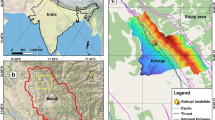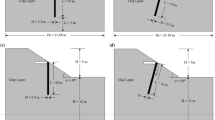Abstract
Field observations have shown that sliding zones in large landslides often exhibit much lower frictional resistances than their ordinary values; this behavior causes great difficulties in predicting the dynamics and runout distances of landslides. Particle breakage is believed to be a reason for inducing frictional weakening. This study aims to reproduce the frictional weakening phenomenon induced by particle breakage in landslides and investigate its effect on the dynamics and runout distances of landslides. A constitutive model capable of simulating the particle breakage development during large shear strain was employed to describe the mechanical behavior of sliding soils. In addition, the material point method (MPM) was adopted to overcome the difficulties in simulating the large deformations of landslides. The simulation results showed that a larger shear deformation in the sliding zone caused greater particle breakage, leading to a greater decrease in the frictional resistance, which in turn aggravated the shear deformation and particle breakage; consequently, concentrated shear deformation and particle breakage were found in the sliding zones. Particle breakage-induced frictional weakening can change the landslide pattern from shallow sliding of a linear sliding surface to deep sliding of a circular sliding surface and significantly increase the runout distance.
Graphical abstract















Similar content being viewed by others
References
Lucas, A., Mangeney, A., Ampuero, J.: Frictional velocity-weakening in landslides on earth and on other planetary bodies. Nat. Commun. 5, 3417 (2014)
Wang, F., Zhang, Y., Huo, Z., Peng, X., Wang, S., Yamasaki, S.: Mechanism for the rapid motion of the qianjiangping landslide during reactivation by the first impoundment of the three gorges dam reservoir, China. Landslides 5, 379–386 (2008)
Dang, K., Sassa, K., Fukuoka, H., Sakai, N., Sato, Y., Takara, K., et al.: Mechanism of two rapid and long-runout landslides in the 16 April 2016 kumamoto earthquake using a ring-shear apparatus and computer simulation (ls-rapid). Landslides 13, 1–10 (2016)
Sassa, K.: Prediction of earthquake induced landslides. Special Lecture at 7th International Symposium on Landslides, Trondheim. Landslide 1, 115–132 (1996)
Sassa, K., Fukuoka, H., Wang, G., Ishikawa, N.: Undrained dynamic-loading ring-shear apparatus and its application to landslide dynamics. Landslides 1, 7–19 (2004)
Hu, W., Huang, R., Mcsaveney, M., Yao, L., Xu, Q., Feng, M., Zhang, X.: Superheated steam, hot CO2 and dynamic recrystallization from frictional heat jointly lubricated a giant landslide: field and experimental evidence. Earth Planet Sci. Lett. 510, 85–93 (2019)
Kent, P.: The transport mechanism in catastrophic rock falls. J. Geol. 74, 79–83 (1966)
Melosh, H.: Dynamical weakening of faults by acoustic fluidization. Nature 379, 601–606 (1996)
Davies, T., Mcsaveney, M., Boulton, C.: Elastic strain energy release from fragmenting grains: effects on fault rupture. J. Struct. Geol. 38, 265–277 (2012)
Iverson, R.M., George, D.L.: Modelling landslide liquefaction, mobility bifurcation and the dynamics of the 2014 Oso disaster. Géotechnique 66, 175–187 (2015)
Iverson, R.M., Reid, M., Logan, M., LaHusen, R., Godt, J.W., Griswold, J.: Positive feedback and momentum growth during debris-flow entrainment of wet bed sediment. Nat. Geosci. 4, 116–121 (2011)
Liu, X., Wang, Y., Li, D.: Numerical simulation of the 1995 rainfall-induced fei tsui road landslide in hong kong: new insights from hydro-mechanically coupled material point method. Landslides 17, 2755–2775 (2020)
Pastor, M., Blanc, T., Haddad, B., Petrone, S., Sanchez, M.M., Drempetic, V., Issler, D., Crosta, G.B., Cascini, L., Sorbino, G., Cuomo, S.: Application of a SPH depth-integrated model to landslide run-out analysis. Landslides 11, 793–812 (2014)
Wang, G., Sassa, K.: Pore-pressure generation and movement of rainfall-induced landslides: effects of grain size and fine-particle content. Eng. Geol. 69, 109–125 (2003)
Sassa, K.: Mechanism of flows in granular soils. In Proceedings of the International Conference on Geotechnical and Geological Engineering, Melbourne, Australia, 19–24 November 2000. A. A. Balkema, Rotterdam, the Netherlands, pp 1671–1702 (2000)
Davies, T., Mcsaveney, M., Hodgson, K.: A fragmentation-spreading model for long- runout rock avalanches. Can. Geotech. J. 36, 1096–1110 (1999)
Sadrekarimi, A., Olson, S.M.: Particle damage observed in ring shear tests on sands. Can. Geotech. J. 47, 497–515 (2010)
Sassa, K., Fukuoka, H., Wang, F., Wang, G.: Dynamic properties of earthquake-induced large-scale rapid landslides within past landslide masses. Landslides 2, 125–134 (2005)
Fukuoka, H., Sassa, K., Wang, G.: Influence of shear speed and normal stress on the shear behavior and shear zone structure of granular materials in naturally drained ring shear tests. Landslides 4, 63–74 (2007)
Okada, Y., Sassa, K., Fukuoka, H.: Excess pore pressure and grain crushing of sands by means of undrained and naturally drained ring-shear tests. Eng. Geol. 75, 325–343 (2004)
Gerolymos, N., Gazetas, G.: A model for grain-crushing-induced landslides—application to Nikawa, Kobe 1995. Soil Dyn. Earthq. Eng. 27, 803–817 (2007)
Gerolymos, N.: Numerical modeling of seismic triggering, evolution, and deposition of rapid landslides: application to Higashi-Takezawa (2004). Int. J. Numer. Anal. Methods Geomech. 34, 383–407 (2010)
Zhang, M., Wang, Z., Sun, L.: Research on rapid and long-runout mechanisms of rockslide debris using ring shear tests (in Chinese). Chin. J. Rock Mech. Eng. 35, 2673–2681 (2016)
Muller, A., Vargas, E.: Stability analysis of a slope under impact of a rock block using the generalized interpolation material point method (GIMP). Landslides 16, 751–764 (2019)
Bisht, V., Salgado, R., Prezzi, M.: Simulating penetration problems in incompressible materials using the material point method. Comput. Geotech. 133, 103593 (2021)
Lorenzo, R., Cunha, R., Neto, M., Nairn, J.: Numerical simulations of deep penetration problems using the material point method. Geomech. Eng. 11, 59–76 (2016)
Ceccato, F., Yerro, A., Girardi, V., Simonini, P.: Two-phase dynamic mpm formulation for unsaturated soil. Comput. Geotech. 129, 103876 (2020)
Ceccato, F., Girardi, V., Simonini, P.: Developing and testing multiphase MPM approaches for the stability of dams and river embankments. In: Proceedings of XXIV AIMETA Conference 2019. AIMETA 2019. Lecture Notes in Mechanical Engineering. Springer, Cham (2020)
Bui, H., Fukagawa, R., Sako, K., Ohno, S.: Lagrangian meshfree particles method (sph) for large deformation and failure flows of geomaterial using elastic-plastic soil constitutive model. Int. J. Numer. Anal. Method Geomech. 32, 1537–1570 (2010)
Mori, H., Fukuhara, N., Hattori, A., Kuwano, R., Sasaki, T.: The sph method for simulating the progressive sliding failure of a river levee. Jpn. Geotech. J. 9, 687–696 (2014)
Karim, M., Nogami, T., Wang, J.: Analysis of transient response of saturated porous elastic soil under cyclic loading using element-free galerkin method. Int. J. Solids Struct. 39, 6011–6033 (2002)
Modaressi, H., Aubert, P.: Elemen-free galerkin method for deforming multiphase porous media. Int. J. Numer. Method Eng. 42, 313–340 (1998)
Jiang, J., Ehret, D., Wei, X., Rohn, J., Ling, H., Yan, S., et al.: Numerical simulation of qiaotou landslide deformation caused by drawdown of the three gorges reservoir, China. Environ. Earth Sci. 62, 411–419 (2011)
Guglielmi, Y., Cappa, F.: Regional-scale relief evolution and large landslides: insights from geomechanical analyses in the tinee valley (southern french alps). Geomorphology 117, 121–129 (2010)
Li, X., Zhao, J., Soga, K.: A new physically based impact model for debris flow. Géotechnique 71(8), 674–685 (2021)
Kong, Y., Li, X., Zhao, J.: Quantifying the transition of impact mechanisms of geophysical flows against flexible barrier. Eng. Geol. 289, 106188 (2021)
Fern, E., Soga, K.: The role of constitutive models in MPM simulations of granular column collapses. Acta Geotech. 11, 659–678 (2016)
Feng, K.W., Wang, G., Huang, D.R., Jin, F.: Material point method for large-deformation modeling of coseismic landslide and liquefaction-induced dam failure. Soil Dyn. Earthq. Eng. 150, 106907 (2021)
Soga, K., Alonso, E., Yerro, A., Kumar, K., Bandara, S.: Trends in large-deformation analysis of landslide mass movements with particular emphasis on the material point method. Géotechnique 66(3), 248–273 (2016)
Einav, I.: Breakage mechanics—part I: theory. J. Mech. Phys. Solids. 55, 1274–1297 (2007)
Hardin, B.: Crushing of soil particles. J. Geotech. Geoenviron. Eng. 111, 1177–1192 (1985)
Indraratna, B., Sun, Q., Nimbalkar, S.: Observed and predicted behaviour of rail ballast under monotonic loading capturing particle breakage. Can. Geotech. J. 52, 73–86 (2015)
Marsal, R.: Mechanical properties of rockfill embankment dam engineering Casagrande Volume, pp. 109–200. Wiley, New York (1973)
Peng, Y., Ding, X., Xiao, Y., Deng, X., Deng, W.: Detailed amount of particle breakage in non-uniformly graded sands under one-dimensional compression. Can. Geotech. J. 57(8), 1239–1246 (2019)
Peng, Y., Liu, H., Li, C., Ding, X., Deng, X., Wang, C.: The detailed particle breakage around the pile in coral sand. Acta Geotech. 16, 1971–1981 (2021)
Wang, G., Wang, Z., Ye, Q., Zha, J.: Particle breakage evolution of coral sand using triaxial compression tests. J. Rock Mech. Geotech. Eng. 13(2), 321–334 (2021)
Chávez, C., Alonso, E.E.: A constitutive model for crushed granular aggregates which includes suction effects. Soils Found. 43(4), 215–228 (2003)
Wang, G., Ye, Q., Zha, J.: Experimental study on mechanical behavior and particle crushing of coral sand-gravel fill (in Chinese). Chin. J. Geotech. Eng. 40(5), 802–810 (2018)
Wang, G., Wang, Z., Ye, Q., Wei, X.: Particle Breakage and deformation behavior of carbonate sand under drained and undrained triaxial compression. Int. J. Geomech. 20, 04020012 (2020)
Wang, Z., Wang, G., Ye, Q.: A constitutive model for crushable sands involving compression and shear induced particle breakage. Comput. Geotech. 126, 103757 (2020)
Li, X., Dafalias, Y.: Dilatancy for Cohesionless soils. Géotechnique 50, 449–460 (2000)
Been, K., Jefferies, M.: A state parameter for sands. Géotechnique 35, 99–112 (1985)
Bandara, S., Soga, K.: Coupling of soil deformation and pore fluid flow using material point method. Comput. Geotech. 63, 199–214 (2015)
Su, Y., Tao, J., Jiang, S., Chen, Z., Lu, J.: Study on the fully coupled thermodynamic fluid–structure interaction with the material point method. Comp. Part Mech. 7(1), 225–240 (2019)
Bardenhagen, S., Kober, E.: The generalized interpolation material point method. Comput. Model Eng. Sci. 5, 477–495 (2004)
Sadeghirad, A., Brannon, R.M., Burghardt, J.: A convected particle domain interpolation technique to extend applicability of the material point method for problems involving massive deformations. Int. J. Numer. Methods Eng. 86, 1435–1456 (2011)
Sadeghirad, A., Brannon, R.M., Guilkey, J.E.: Second-order convected particle domain interpolation (CPDI2) with enrichment for weak discontinuities at material interfaces. Int. J. Numer. Methods Eng. 95, 928–952 (2013)
Steffen, M., Kirby, R.M., Berzins, M.: Analysis and reduction of quadrature errors in the material point method (MPM). Int. J. Numer. Anal. Methods Geomech. 76, 922–948 (2008)
Yang, X., Yang, Z., Zhu, S., He, P., Guo, R.: Researches on failure criteria of Lade-Duncan, Matsuoka-Nakai and Ottosen. Chin. J. Geotech. Eng. 28(3), 337–342 (2006)
Xu, Z.H., Sun, D.W.: Experimental study of rockfill particle breakage. Adv. Mater. Res. 900, 445–448 (2014)
Sulsky, D., Zhou, S., Howard, L.: Application of a particle-in-cell method to solid mechanics. Comput. Phys. Commun. 87(1–2), 236–252 (1995)
Richart, F.E., Jr., Hall, J.R., Woods, R.D.: Vibrations of soils and foundations. Prentice-Hall, Englewood Cliffs (1970)
Ishihara, K., Tatsuoka, F., Yasuda, S.: Undrained deformation and liquefaction of sand under cyclic stresses. Soils Found. 15(1), 29–44 (1975)
Huang, M.S., Li, X.F., Jia, C.Q.: A double yield surface constitutive model for sand based on state-dependent critical state theory (in Chinese). Chin. J. Geotech. Eng. 32(11), 1764–1771 (2010)
Muir Wood, D., Maeda, K.: Changing grading of soil: effect on critical states. Acta Geotech. 3(1), 3–14 (2007)
Ciantia, M.O., Arroyo, M., O’Sullivan, C., Gens, A., Liu, T.: Grading evolution and critical state in a discrete numerical model of Fontainebleau sand. Geotechnique 69(1), 1–15 (2019)
Acknowledgements
This research was supported by National Natural Science Foundation of China (Grants 52079012) and Graduate Research and Innovation Foundation of Chongqing, China (Grant No. CYB20032).
Author information
Authors and Affiliations
Corresponding author
Additional information
Publisher's Note
Springer Nature remains neutral with regard to jurisdictional claims in published maps and institutional affiliations.
Rights and permissions
About this article
Cite this article
Wang, Z., Wang, G. Effect of particle breakage-induced frictional weakening on the dynamics of landslides. Granular Matter 24, 72 (2022). https://doi.org/10.1007/s10035-022-01234-6
Received:
Accepted:
Published:
DOI: https://doi.org/10.1007/s10035-022-01234-6




